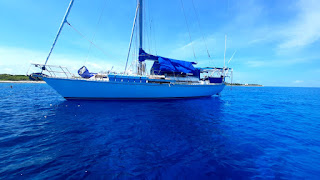 |
| lake Atitlan |
 |
| Chicken Buses |
While in Antigua we decided to explore the surroundings and
went by “chicken-bus” to Lake Atitlan. A chicken bus (Spanish:
"camioneta" or "trambilla") is a colorful, modified and
decorated retired North American school bus. The word "chicken" refers
to the fact that rural Guatemalans occasionally transport live animals on these
buses. The bus dropped us of at the largest town on the shore, Panajachel,
which is overwhelmed by tourists.
 |
| Traditional dress |
The lake is surrounded by many villages, in which Maya
culture is still prevalent and traditional dress is worn. The Maya people of
Atitlán are predominantly Tz'utujil and Kaqchikel. There is no road that
circles the lake. Communities are reached by boat or roads from the mountains
that may have brief extensions along the shore.
 |
| Casa del Mundo |
Jaco surprised me with a reservation of one night at “Casa
del Mundo”, one of Guatemala's most magical hotels. Perched on a secluded
cliff, it has gorgeous gardens, swimming holes and a hot tub overhanging the
lake. It is accessible only by boat or on foot. We paid N$275 for a double room
with a spectacular view over the lake (even from our bed!) and a shared
bathroom.
 |
| Bed with a view. |
 |
| View from outside our room |
 |
| On the footpath to El Jabilato |
In day time we explored the foot trails leading to the surrounding villages. An ancient Mayan trail passes through the heights of the property to Santa Cruz and further. (The trail is lovely, but this village is not really worth a visit.) The hotel borders the small indigenous village of El Jaibalito. There is a German owned backpackers which serves affordable delicious local food.
 |
| View from the Santa Cruz trail. |

The evening we joined the other hotel guests at a very romantic dinner and met Werner and Christina South African / German sailors.
The “Cherry on top” (alla good friend Hisham) after the delicious dinner and good company was when our waiter called on us “excuse me sir, your tub is ready”!
Geared with a good bottle of Guatemalan Rum and two travel plastic glasses we joined 4 other guests in the hot tub overhanging the lake. Under starry sky we looked upon the twinkeling lights on the opposite shores of the lake. Not too long after our arrival, we had the tub for ourselves…… not sure if our companions caught a fright from our Rum Bottle, but never the less, we spend a memorable evening alone in the hot tub cooling down now and again in the cold lake. Jaco found the construction of the tub very interesting with the heat coming from a stainless steel, wood burning box (in Namibia we call it a donkey) build inside a cement pool.
 |
| the famous tub. |
 |
| fishermen on Kayaks |
The following morning we skipped the expensive breakfast at
our hotel and enjoyed a cheap local breakfast at the backpackers. Thereafter we
kayaked for an hour on the lake before we returned to reality and back to Panajachel!
 |
| waiting for the boat taxi |
 |
| The lake water level raised in resent years, submerging some buildings. |
 |
| Craft Market at Panajachel |
While Jaco was haggling a travel agent for cheap bus tickets straight back to Rio Dulce, Songerie, I bargained a couple of craft sellers to tears for a few table cloths/runners for presents back home!
 |
| just so much to buy! |
Lake Atitlán (Atitlan meaning "At the water" in Nahuatl) is a large lake that does not flow to the sea. It is the deepest lake in Central America with maximum depth about 340 meters.
The lake has three volcanoes on its southern flank and characterized by towns and villages of the Maya people.
The lake is volcanic in origin, filling an enormous caldera formed in an eruption 84,000 years ago. It is about 50 km west-northwest of Antigua.
The three Volcanoes are Volcán Atitlán, on the southern rim of the caldera, (has grown in the last 10,000 years, and remains active, with its most recent eruption 1853) while the other two lie within the caldera, Volcán San Pedro (the oldest of the three and have stopped erupting about 40,000 years ago) and Volcán Tolimán (began growing after San Pedro stopped erupting, and probably remains active, although it has not erupted in historic times).
The massive earthquake (7.5 magnitude - killing 26 000 people in Guatemala) in 1976 fractured the lake bed causing subsurface drainage from the lake, allowing the water level to drop two meters within one month.
They have found several Mayan archaeological sites at the lake, under the water through out the years.
 |
| all Ages are selling something, old |
 |
| and young |
 |
| 4 different types of bananas at the agricultural market. |
The lake basin supports extensive coffee growth and corn. Other agricultural products include onions, beans, squash, tomatoes, cucumbers, garlic, chile verde, strawberries, avocados and pitahaya fruit.
 |
| stawberries. |
 |
| every where is traditional dress. |
We left Panajachel at 12h by bus via Antigua, Guatemala city and were back at Rio Dulce onboard Songerie at 10pm..




























